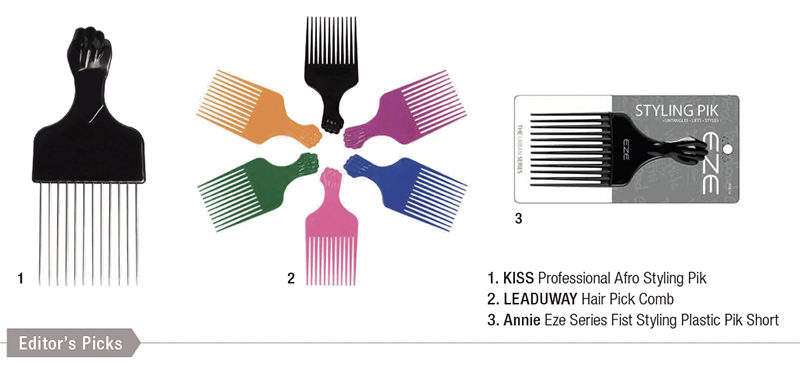Combs and Brushes That Attract Customers
Among the many items handled by Beauty Supply, combs and brushes are not really important items. However, this small tool is like ‘light and salt’, as it could ruin or save customers’ hair. In particular, flat, thin and curly African hair will tangle, break, or even shatter if not properly brushed. The secret to winning the inevitable battle against combing is knowing the right product for each person’s hair. We have dug deeply into Beauty Supply’s essential item, combs and brushes for our readers.
Comb vs Brush
Basically, the comb is elongated vertically like a blade, and the brush is spread over a wide area and uses materials such as pig hair and nylon. Usually, the two are used interchangeably as a tool for combing hair, but their basic uses are different.

Combs mainly serve to stop hair from tangling. Especially for curly hair, combing should be done when the hair is wet, because that way, the hair is easier to comb and it falls out less.
Brushes are usually used after combing hair. It cleans and moisturizes hair and massages the scalp to promote blood circulation. Also, oil from the sebaceous glands is delivered to the end of the hair to create elastic and shiny hair.
Combs and brushes should be used properly as they are an important part of healthy hair care.
PART1 “Common” Sense for Comb & Brush Use
Features by Shape
Wide Tooth Comb
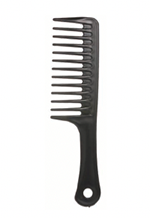
– Thick and wide-spaced flat comb
– Mainly used to loosen or neaten tangled hair. It untangles hair while maintaining the curls, thus, good for setting style
Tip
√ When untangling hair, comb the hair little by little from the tip of the hair
√ When used after applying conditioner to the hair, it helps conditioner to be evenly distributed throughout the hair
Tail Comb
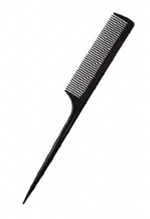
– Flat and thin comb with teeth that are narrowly spaced
– The comb is dense and the tail is sharp, so it is used to part hair or when elaborate combing is required. Perfect for styling complicated and detailed sections such as bangs and roots
Tip
√ When you want your styled hair to last for a long time, spray the comb slightly with fixing spray then comb your hair.
All-Purpose Comb
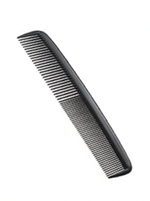
– A comb with two sides; one with narrow-spaced teeth and one with wide-spaced teeth
– Like the name, it can be used for men’s, women’s, and children’s hair
Tip
√ A wide-spaced comb is good for work such as loosening hair tangles quickly. On the other hand, a narrow-spaced comb is good for more detailed work such as finishing
Teasing Comb/brush
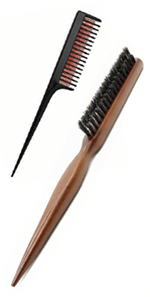
– “Teasing” means combing backward to puff up hair, a.k.a. “backcombing.”
– It has both short and long teeth, suitable for increasing the volume of the hair roots. Teasing combs are fit for thick, curly hair while teasing brushes are fit for thin and short hair
Tip
√ Brush backwards toward the scalp from about 0.5 to 1 inch away from the root, and do not use on wet hair
√ Some say that frequent backcombing can cause hair damage, so be careful
Roll Brush
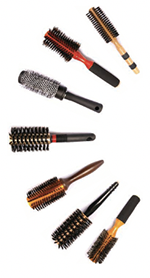
– A brush suitable for styling, such as making waves, than hair care. The thicker the “roll,” the easier to straighten the hair, and thinner the roll, the easier it is to make wavy hair
– Roll brushes made of natural animal fur are used to create bold and heavy styles, and ceramic rolls are used to style hair quickly
Tip
√ Roll brushes made of natural fur or boar bristle is a is effective for removing dirt and grease, so it is good for people with scalp problems
Paddle Brush
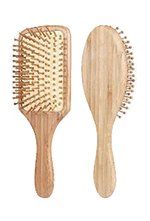
– Known for their rounded ends and wids, elastic cushions (also called ‘cushion brush’)
– The teeth are spaced wide and the ends of them are blunt, causing less irritation to the hair and scalp. You can also massage the scalp by lightly hitting the head with it
Tip
√ There is less irritation when combing hair, so it is good to use by people who worry about hair loss
√ Wooden paddle brushes can protect hair in winter with static shock prevention
Vent Brush
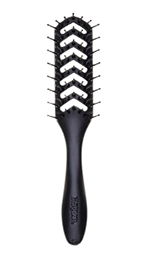
– Holes are at the back of the brush head, and the teeth are arranged so that they look similar to fish bones, thus the nickname “skeleton brush”
– Very breathable, so hair drys quickly and neatly when drying. Perfect for adding volume to hair as well
Tip
√ Made with flexible teeth, it gently loosens tangled hair, especially good for people with lots of hair
Features by Material
나무
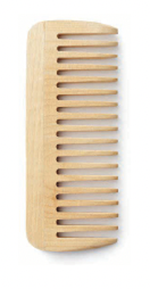
– Good for hair and scalp, prevents static
– Less heat damage when drying
√ Chestnut helps blood circulation of the scalp and helps the hair roots stay healthy
Nylon
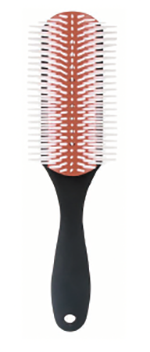
– Prevents hair loss because it’s thin and flexible
– Effective on easily tangled hair!
√ Prone to static, so be careful when using on dry hair
Boar Hair
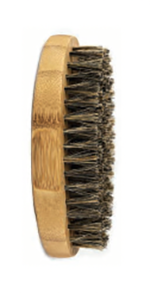
– Made from natural wild boar hair
– Gently removes dirt and grease from hair and scalp, helps create elastic and shiny hair
√ Dirt is easy to build up, so you need to wash regularly
Metal
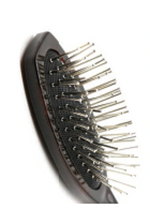
– The ends of metal teeth are rounded, so no snags or pulling
– great for untangling severely tangled hair
√ Do not use it when blow drying, as it can heat up and damage the scalp or hair
Ceramic
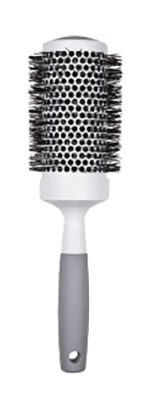
– Delivers heat well and helps quicker styling but minimizes hair damage
– Lasts longer than other brushes
√ Nowadays, reinforced ceramic resistant to heaand chemicals and prevents static electricity, “Carbon,” is a popular material
Plastic
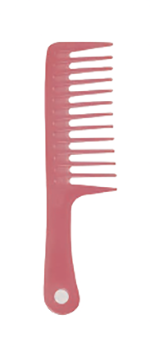
– Lightweight and cheap, but prone to static
– Combs with less teeth are recommended to use
√ If your hair is not strong and falls out well, apply essence before brushing
3 Steps to Comb Care
STEP1 Remove hair tangled in comb using toothpicks or scissors
STEP2 mix shampoo in warm water until water is foamy, and soak the comb for 10 minutes
STEP3 Rinse several times with clean water and dry in the sun
√ However, it is better to use vegetable oil instead of water when cleaning a wooden comb or brush and wipe it with a cloth
How to Brush Hair “Well”
Why do you need to brush your hair? Combing is the most basic method of grooming that stimulates the blood flow of the scalp and strengthens the hair roots. In addition, for healthy hair, the outer surface of the hair, which is surrounded by ‘cuticles‘, needs to be tidied up. If you do not properly manage the cuticles that act as the door that protects the hair, the hair is easily damaged by ultraviolet light and various contaminants, and it is easy to end up with extremely damaged hair.
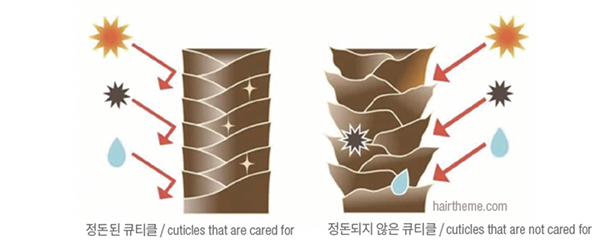
Just like athletes stretch before exercising, we can make hair healthy just by adding a brushing step using a comb before shampooing. Hair care experts recommend combing hair twice a day, morning and evening to disperse the natural oils of the scalp onto the hair. However, the brushing method of wet and dry hair should be different.
How to Comb Wet Hair
- Brush the ends of the hair with a brush/comb to gently remove the tangled parts.
- If the tangle is severe, apply a tangle remover or conditioner to smooth and loosen the hair
- Once the hair ends are cleaned up, climb up a few inches and start combing down again
-
Repeat the process until all tangles are gone and you have reached the scalp
How to Comb Dry Hair
1. Comb to the end, starting from the middle or a few inches away from the end
2. Move 1-2 inches up and continue combing down until you remove all tangles
3. Continue to go up and repeat until you reach the scalp, and then comb the entire hair a few times
4. Most damage occurs when combing coarsely. Brush slowly and carefully
You Need to Brush Wigs “Well” Too
Wigs, unlike real hair on a person, are not nourished, so if they are not properly cared for, they have a short life and they are prone to tangling. In addition, when worn, it does not shine, so it can be fluffy like doll hair and won’t look natural. Therefore, wigs have to be cared for just like human hair, and the most basic step is brushing. Since they tangle so easily, you must brush slowly starting from the bottom and make your way up.
How to Brush Wigs

shelahair.com
What if it’s a straight wig? Straight wigs do not have any styling, so any comb is passable. For shiny, smooth wigs, use a dense comb and brush from the bottom and make your way to the top slowly.
What if it’s a wavy wig? Wigs with waves are already styled, so dense combs and brushes should be avoided. If you comb it with a wide tooth comb, the waviness will become neater and you will be able to wear natural-looking wigs. After combing, twist the curl with your fingers in the direction of the wave to maintain the wave.
What if it’s a damaged wig? We recommend wooden products rather than nylon and plastic. This is because wood absorbs oil and does not cause static, thus, it maintains the hair clean. However, wooden combs can be bent or deformed with water, so when combing with a wooden comb, make sure it doesn’t touch the water.
Tip √ In beauty supply stores, all of the combs are usually collected and displayed in the miscellaneous goods corner. Like the items next to the counter of stores, if you place a comb useful for wig management on one side of the Wig section, you can expect that the comb would sell along with the wig.
PART 2 Top 10 Combs and Brushes for Afro Hair
- Detangling brush
The detangling brush, which is arranged with different heights of bristle, is useful for calmly arranging frequently tangled hair. The row of the brush naturally widens while brushing and reduces irritation. Thus, brushing can be done without hair loss or snagging.

- Tangle teezer
This is a product of a British hairbrush brand that sells one every five seconds in 75 countries around the world, and even has the title “5 Second Brush.” It has a double bristle structure; the long bristle untangles hair, and the short bristle arranges the hair to make it smooth.

- Military brush
It is usually made of boar hair, and the dense bristles stimulate the scalp and induce healthy hair growth. Also, it spreads natural oil on the hair and creates a steady wave. It is mainly used for short hair, so many men use this brush. It is also useful for grooming beards and mustaches, not just hair.

- Edge brush
It is used to style the hairline. There is usually a brush head at one end to hold the strands and a small comb at the other end to smooth the hair. Some products have brushes and combs together front and back. You can create a variety of styles using edge control products such as hairgels and pomades.
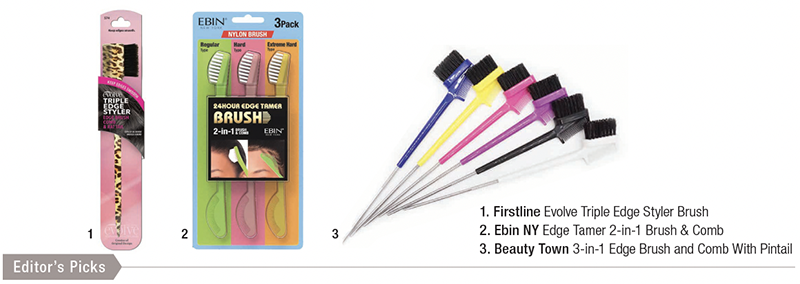
- Denman brush
It is a collection of brushes designed by John Denman Dean in the 1930s, and is considered a must-have item when solving the tangle problems of curly hair. In particular, Dunman’s ‘Classic Traditional Styling Brush’ is widely known as Vidal Sassoon’s favorite, featuring seven nylon pin rows with rounded ends, and is used when you want to straighten your curls or add gloss and volume to your hair.

- Double detangler comb
Especially useful for combing wet or curly hair. There are two rows of teeth, a row with longer teeth that reaches between the dense curly hair to help combing, and a shorter row that arranges the curls and prevents the hair from twisting.

- Braiding comb (Parting comb)
Originally a traditional comb used in West Africa, it has three teeth and is used to divide hair when doing styles such as Cornrows, Braids, Weave, and Wash and go. There are also fish comb types that allows you to detangle and style at once.

- Wide tooth comb
The big gaps between teeth allow smooth combing without damaging the hair ends, and is excellent for getting rid of tangles. It is good to use while conditioning your hair during your shower to provide moisture and nutrition to the ends of your hair.

- Brush for hair extensions
Hair extensions may be damaged or pulled during combing. The extension brush protects the extension joining part, while keeping it intact and extending its life.

- Pick comb
Pick (also spelled as ’Pik’) is a comb used vertically and is the best grooming tool for natural hair. The teeth are long and hard, which is effective for grooming curly or dense hair, and creates a large and voluminous ‘Afro’ style by lifting the roots.
